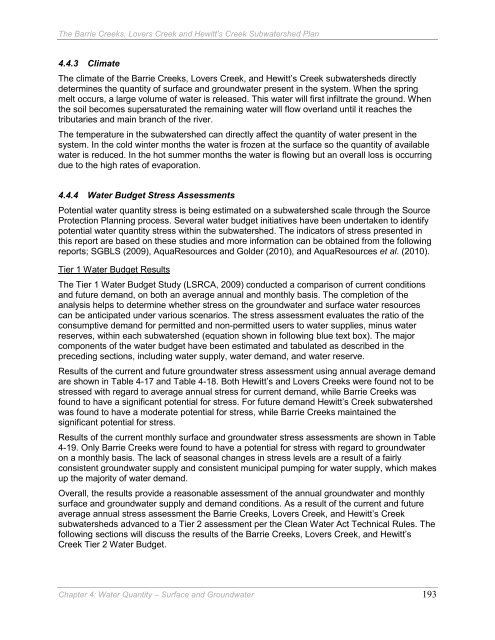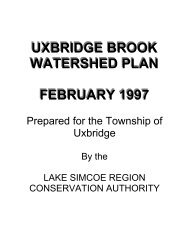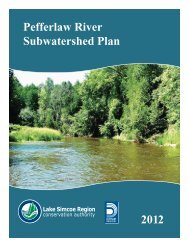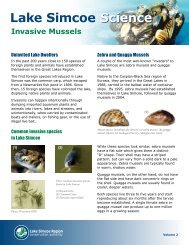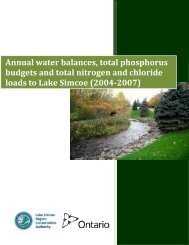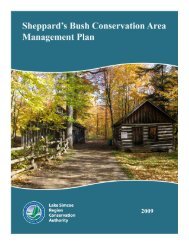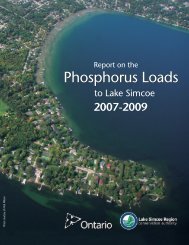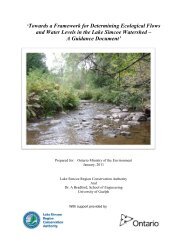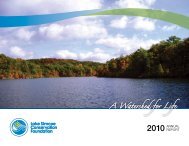Barrie Creeks, Lovers Creek, and Hewitt's Creek Subwatershed Plan
Barrie Creeks, Lovers Creek, and Hewitt's Creek Subwatershed Plan
Barrie Creeks, Lovers Creek, and Hewitt's Creek Subwatershed Plan
Create successful ePaper yourself
Turn your PDF publications into a flip-book with our unique Google optimized e-Paper software.
The <strong>Barrie</strong> <strong><strong>Creek</strong>s</strong>, <strong>Lovers</strong> <strong>Creek</strong> <strong>and</strong> Hewitt’s <strong>Creek</strong> <strong>Subwatershed</strong> <strong>Plan</strong><br />
4.4.3 Climate<br />
The climate of the <strong>Barrie</strong> <strong><strong>Creek</strong>s</strong>, <strong>Lovers</strong> <strong>Creek</strong>, <strong>and</strong> Hewitt’s <strong>Creek</strong> subwatersheds directly<br />
determines the quantity of surface <strong>and</strong> groundwater present in the system. When the spring<br />
melt occurs, a large volume of water is released. This water will first infiltrate the ground. When<br />
the soil becomes supersaturated the remaining water will flow overl<strong>and</strong> until it reaches the<br />
tributaries <strong>and</strong> main branch of the river.<br />
The temperature in the subwatershed can directly affect the quantity of water present in the<br />
system. In the cold winter months the water is frozen at the surface so the quantity of available<br />
water is reduced. In the hot summer months the water is flowing but an overall loss is occurring<br />
due to the high rates of evaporation.<br />
4.4.4 Water Budget Stress Assessments<br />
Potential water quantity stress is being estimated on a subwatershed scale through the Source<br />
Protection <strong>Plan</strong>ning process. Several water budget initiatives have been undertaken to identify<br />
potential water quantity stress within the subwatershed. The indicators of stress presented in<br />
this report are based on these studies <strong>and</strong> more information can be obtained from the following<br />
reports; SGBLS (2009), AquaResources <strong>and</strong> Golder (2010), <strong>and</strong> AquaResources et al. (2010).<br />
Tier 1 Water Budget Results<br />
The Tier 1 Water Budget Study (LSRCA, 2009) conducted a comparison of current conditions<br />
<strong>and</strong> future dem<strong>and</strong>, on both an average annual <strong>and</strong> monthly basis. The completion of the<br />
analysis helps to determine whether stress on the groundwater <strong>and</strong> surface water resources<br />
can be anticipated under various scenarios. The stress assessment evaluates the ratio of the<br />
consumptive dem<strong>and</strong> for permitted <strong>and</strong> non-permitted users to water supplies, minus water<br />
reserves, within each subwatershed (equation shown in following blue text box). The major<br />
components of the water budget have been estimated <strong>and</strong> tabulated as described in the<br />
preceding sections, including water supply, water dem<strong>and</strong>, <strong>and</strong> water reserve.<br />
Results of the current <strong>and</strong> future groundwater stress assessment using annual average dem<strong>and</strong><br />
are shown in Table 4-17 <strong>and</strong> Table 4-18. Both Hewitt’s <strong>and</strong> <strong>Lovers</strong> <strong><strong>Creek</strong>s</strong> were found not to be<br />
stressed with regard to average annual stress for current dem<strong>and</strong>, while <strong>Barrie</strong> <strong><strong>Creek</strong>s</strong> was<br />
found to have a significant potential for stress. For future dem<strong>and</strong> Hewitt’s <strong>Creek</strong> subwatershed<br />
was found to have a moderate potential for stress, while <strong>Barrie</strong> <strong><strong>Creek</strong>s</strong> maintained the<br />
significant potential for stress.<br />
Results of the current monthly surface <strong>and</strong> groundwater stress assessments are shown in Table<br />
4-19. Only <strong>Barrie</strong> <strong><strong>Creek</strong>s</strong> were found to have a potential for stress with regard to groundwater<br />
on a monthly basis. The lack of seasonal changes in stress levels are a result of a fairly<br />
consistent groundwater supply <strong>and</strong> consistent municipal pumping for water supply, which makes<br />
up the majority of water dem<strong>and</strong>.<br />
Overall, the results provide a reasonable assessment of the annual groundwater <strong>and</strong> monthly<br />
surface <strong>and</strong> groundwater supply <strong>and</strong> dem<strong>and</strong> conditions. As a result of the current <strong>and</strong> future<br />
average annual stress assessment the <strong>Barrie</strong> <strong><strong>Creek</strong>s</strong>, <strong>Lovers</strong> <strong>Creek</strong>, <strong>and</strong> Hewitt’s <strong>Creek</strong><br />
subwatersheds advanced to a Tier 2 assessment per the Clean Water Act Technical Rules. The<br />
following sections will discuss the results of the <strong>Barrie</strong> <strong><strong>Creek</strong>s</strong>, <strong>Lovers</strong> <strong>Creek</strong>, <strong>and</strong> Hewitt’s<br />
<strong>Creek</strong> Tier 2 Water Budget.<br />
Chapter 4: Water Quantity – Surface <strong>and</strong> Groundwater 193


